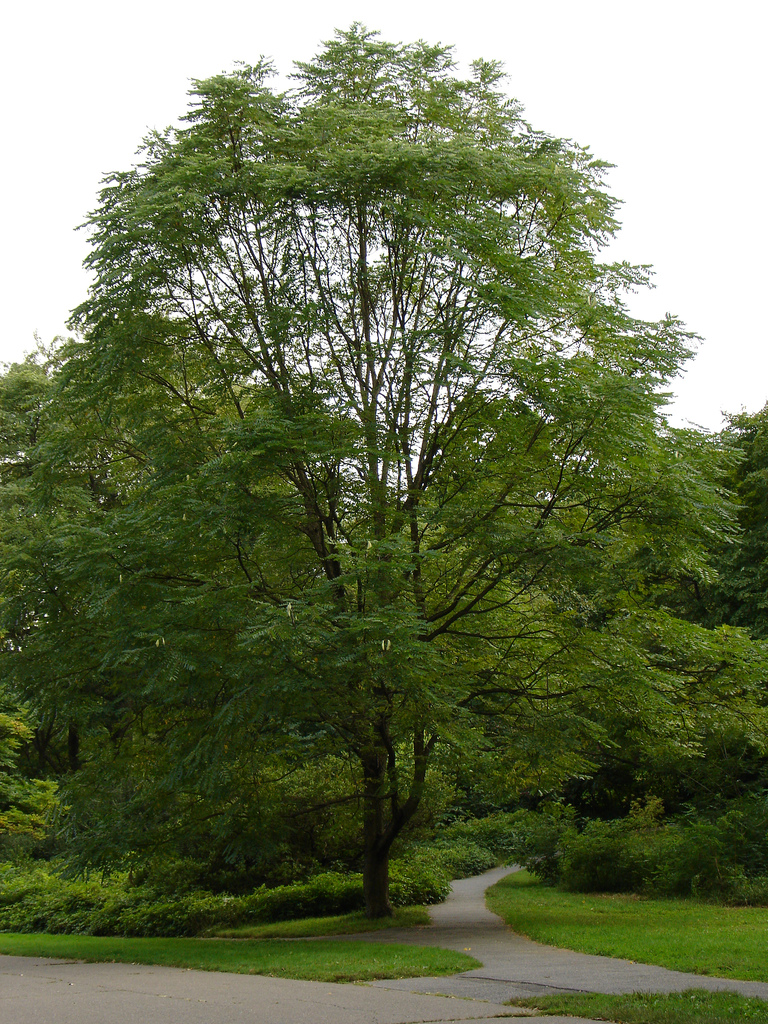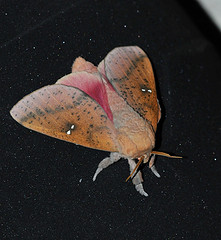Since I released my Guide to Selecting Shade trees, I have meant to write a post about the most frequently recommended tree from it. Here it is, the Espresso Kentucky Coffeetree.

So what makes the Espresso Kentucky Coffeetree so special?
No, it’s not that you can brew coffee from it. Early settlers did brew a coffee like drink from the seeds. I am guessing most people would prefer old coffee from any dumpy gas station before that beverage. Especially considering the seeds are poisonous.

photo credit: geneva_wirth via photopin cc
What makes it special is not any one thing. It is the sum of its positives. They include:
- Attractive bold winter habit and bark
- Clean dark blue green leaves
- Free of insect and disease problems
- Adaptable to city conditions
- Native that supports some wildlife
- ‘Espresso’ has a classic Elm like form
- ‘Espresso’ is fruitless

photo credit: geneva_wirth via photopin cc

It is native and supports native wildlife. Although since the seeds are poisonous, they are mostly avoided by mammals. The Honey Locust Moth does feed on it’s leaves. Bumblebees, Tiger Swallowtail butterflies, and the Ruby Throated Humming bird visit it’s flowers.
The seed pods are not unattractive, but some people consider them messy. ‘Espresso’ is seedless.
Espresso Kentucky Coffeetree Details
Gymnocladus dioicus ‘Espresso’
Hardiness Zones: Zone 3
Exposure: Full sun to Partial sun
Height: 50′
Width: 35′
Features: Picturesque vase-shaped form. Bold and attractive branch structure. Large compound leaves. It has a similar leaf to a walnut tree but is without that trees problems.
Growth Habit: Upright vase shaped form.
Fall Color: Yellow. Some years very attractive, some years not much. Fall color quality is not reliable.


Care and Growing Tips:
Water deeply when first establishing the tree. After established,it is very adaptable to both dry and moist soil. It also grows well in acidic or alkaline soil. It should do just fine under most home landscape conditions. It is also tolerant of salt and pollution.
Espresso Kentucky Coffeetree is best pruned in late winter.
Thanks to it’s poisonous leaves, deer leave it alone.
Verdict: When I was researching the best trees for different growing conditions, this tree kept coming up. If it had reliably good fall color, it would be close to the perfect shade tree. The next time I plant a large shade tree, there is a good chance it will be this tree. Highly recommended.
Click here for more information on the Espresso Kentucky Coffeetree
Seth says
I would like to know how soon trees take to flower. A local nursery has two 8ft tall trees. I am looking to get the male kuntucky coffee tree.
Linda S Bartlett says
I live in southwestern Ohio and have 20′ of space between two driveways. I’m looking for a shade tree (it will be to the west of my house, so someday may help with evening sun on my patio) that will not drop a lot of stuff on cars & driveways, with high enough branches we can easily drive under. Our driveway is porous asphalt, so plenty of water should get through to the roots. Would an Espresso Kentucky Coffeetree be a good choice? Or is there something else you’d recommend?
Martha Plante says
We planted a small (7′?) Espresso K.Coffee Tree 2 years ago. It has 3 branches from the main trunk that all go out laterally, with the leaves coming up from them. I’m worried that it will have this fork at about 8′ so when it gets large it will be prone to splitting. If we prune the lateral branches back in the winter, will it sprout new leaders from them that are closer to the trunk (go up instead of out)?
Nan says
Live in minnesota. Should I wrap the trunk during our harsh winters? City planted in my yard last summer. Young tree trunk about 3 inches in diameter.
Simon says
Hello. My 19th century farmhouse in south central PA had two enormous coffeetrees and about a dozen “smaller” ones, still over 50 feet, when I moved here about 35 years ago. None of my trees have ever had pods, but they’re definitely not recently cultivated. That’s always puzzled me. Sadly, the prior owner of the house had topped the two giants – just sliced off the top of the trunk horizontally – and they slowly died. I had to cut them down two years ago ago. It was heartbreaking, but they were dropping limbs on and near the house that were bigger than most trees. The trunks had hollowed out down to about 10 feet from the ground. Also, a tornado had passed through here about 15 years ago and knocked down several of the younger ones, so now I’m left with only three mature trees and two enormous stumps. However, baby trees are sprouting all over the yard, zillions of them, since those big guys were cut down. We always had a few popping up here and there, but this is ridiculous. They’re everywhere. I’d like to transplant some of the volunteers in desirable spots and maybe pot some to give to friends, but when I try to move one or pot it, it dies. Any suggestions about how to save some of these baby coffeetrees?
nunya beeswax says
the link for your “Guide to Selecting Shade trees” doesn’t appear to be working… where can i find this article?
thank you
Richard Fullmer says
Thank you Doug. We appreciate your comments and are anxiously awaiting spring to see new growth! The advice about watering was much appreciated because we probably are over watering. We both grew up in sandy and rocky soil and have had to water, water, water to keep our trees growing. But here, the soil is more compact and does hold the water well. So thanks again, those cracks I talked about seem to have healed over.
doug terhune says
Hi Richard,
Kentucky coffee trees develop a very corrugated bark, starting when the stem reaches about 1.25″ in diameter. That ” corrugation ” starts out as intermittent vertical stripes, much like what you have described. It may just be that what you are seeing is normal bark development.
Kentucky coffee trees don’t normally suffer from borer damage, but that is also a possibility. I would suggest taking a photo of the bark issue and going to your county extension agent. Hopefully it is normal bark growth.
A side note: Unless you have very sandy soil and live in a particularly hot and windy environment your K.C. trees shouldn’t need to be deep soaked that often, especially since you have nice big mulched tree rings around them. This is one of the true beauties of K.C. trees, they are very drought tolerant and you may actually be over watering them if you don’t have porous soil.
You have chosen a great tree. Hopefully the bark issue is from growth.
Good luck!
Jim says
Thanks for the info Doug.
Richard Fullmer says
We planted an 8 foot new tree in May of 2017. It seems to be doing very well however, today we noticed that
the bark on the tree is splitting open at intervals. There are about 5 splits all in a line on the east side of tree
trunk. Any clues as to what is causing this? We can send pictures if you will tell me how. Thanks!
Jim says
Trunk damage most likely. Perhaps caused by line trimmer or lawn mower running into. It should heal over with time.
Richard Fullmer says
We know it is not from lawn mower or trimmer damage. The tree is mulched in a 6 foot diameter. We deep water the base of the tree every Wednesday to make sure the roots are staying wet. Could excess water around the roots cause it to crack. The cracking is an up and down the trunk, like dash lines for about 5 feet up the trunk from the ground all in a straight line on east side of tree. Thanks for answering our 1st question.
Richard Fullmer
Peter Clark says
A fantastic high canopy shade tree! Plated two from root stock at my old residence. One (podded) female and one (podd-less) male. Grew from 6′ at planting to >30′ in 16 years. Will be planting four at our new home. All will be Espresso®.
Jessica Hinterman says
About how much height does the espresso Kentucky coffee tree typically grow in an average year? (At least, I hope it’s feet and not inches!)
Jim says
About a foot a year. I have heard that it can speed up after it is really established. Of course your climate will influence it a bit.
Richard says
Hi, Jim.
Just found your website by the “Espresso” Kentucky Coffee Tree entry. Nice clone, BTW. Is it a male that’s grafted, or is it from root cuttings?
I have a Kentucky Coffee Tree that I started from seed, and it is growing slowly in Palm Desert, CA. I collected it in Kansas, so it is a memory for me. Unknown if it is male or female, but I don’t believe pods will be a problem: I’m betting it’s the only one in Palm Desert.
Recently, I discovered a new Caesalpinia for me, C. mexicana. It’s a small tree (smaller than the Eastern Redbud another favorite of mine), and should be very adaptable as a small patio shade tree, with beautiful yellow flowers. However, even though it is a U.S. native (barely), it is very subtropical, and would not survive very far north. If you want to expand your database to the Southwest, it’s worth mentioning.
Jim says
Hi Richard,
I don’t know for sure how it is usually grown, but I know they can be grown from root cuttings or tissue culture, so I bet it is NOT a graft. It will be interesting to see how yours grows in that climate. It is certainly far from home.
Thanks for the info, While I don’t even pretend to know much about the wide variety of plants in the Southwest, it is always good to learn a new tree that may fit someones landscape. That one looks like a winner for those in it’s climate.